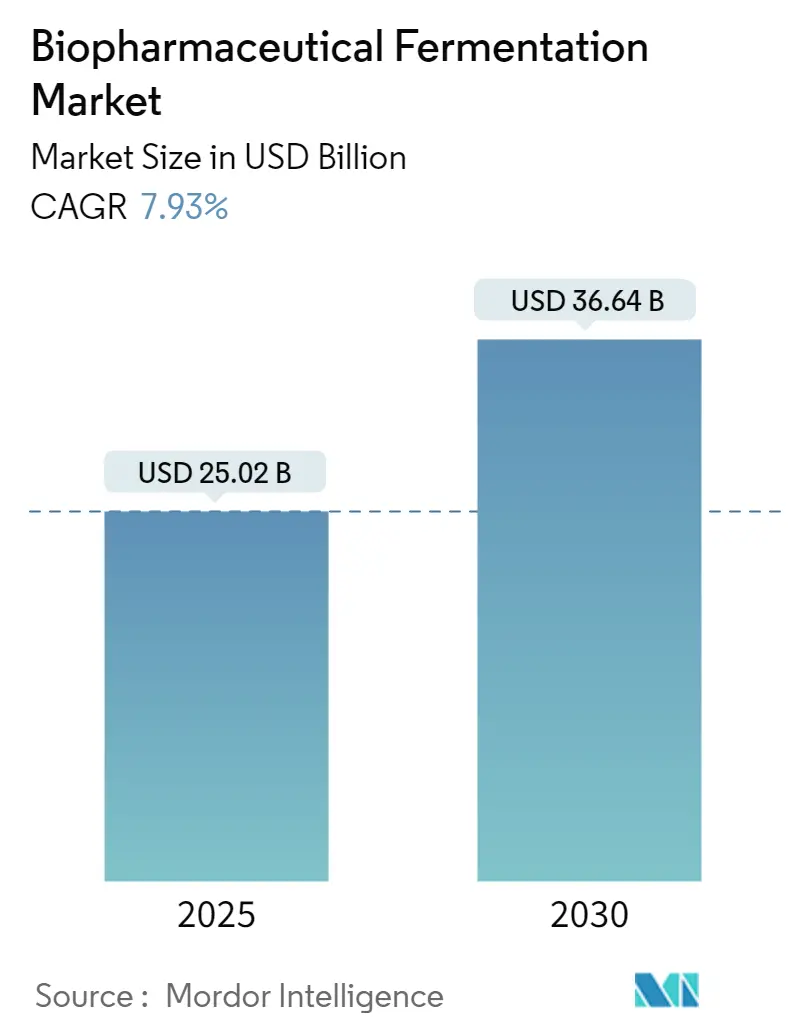
| Study Period | 2021 - 2030 |
| Market Size (2025) | USD 25.02 Billion |
| Market Size (2030) | USD 36.64 Billion |
| CAGR (2025 - 2030) | 7.93 % |
| Fastest Growing Market | Asia-Pacific |
| Largest Market | North America |
| Market Concentration | Low |
Major Players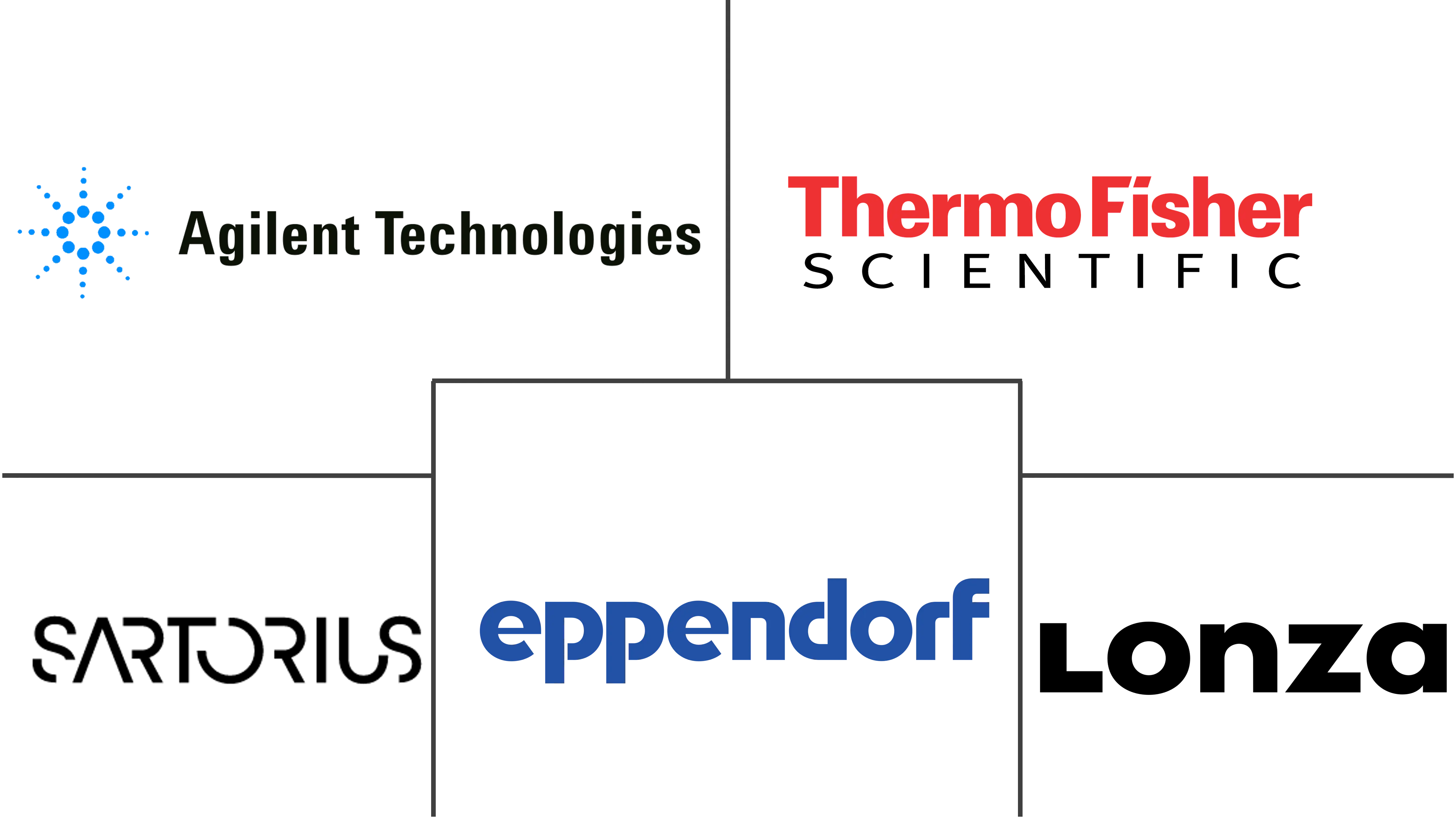
*Disclaimer: Major Players sorted in no particular order |
Biopharmaceutical Fermentation Market Analysis
The Biopharmaceutical Fermentation Market size is estimated at USD 25.02 billion in 2025, and is expected to reach USD 36.64 billion by 2030, at a CAGR of 7.93% during the forecast period (2025-2030).
The biopharmaceutical fermentation industry is experiencing a significant transformation driven by technological advancements in bioprocess technology and automation. Single-use technologies are emerging as a prominent trend in biomanufacturing, although stainless-steel systems continue to dominate microbial fermentation processes. The integration of advanced analytics and process monitoring systems has enhanced production efficiency and quality control measures. This evolution is particularly evident in the development of next-generation biotherapeutics, where precision fermentation technology techniques are becoming increasingly crucial for producing complex biological molecules.
Strategic partnerships and collaborations are reshaping the competitive landscape of the biopharmaceutical fermentation market. In December 2023, Merck's acquisition of Massachusetts-based Erbi Biosystems, developer of the 2ml micro-bioreactor platform technology, demonstrates the industry's focus on expanding capabilities in therapeutic protein production. The integration of scalable cell-based perfusion bioreactor processes, ranging from 2ml to 2000L, represents a significant advancement in bioprocess technology. These strategic moves are enabling companies to enhance their manufacturing capabilities and accelerate the development of novel biological products.
Manufacturing capacity expansion initiatives are gaining momentum across the industry. In September 2023, Aurobindo Pharma and its subsidiary CuraTeQ Biologics announced a USD 37 million investment in biologics expansion, with operations scheduled to commence by fiscal year 2026. Similarly, BIOVECTRA's launch of its single-use biologics fermentation suite in Windsor, Nova Scotia, marks a significant advancement in commercial-scale biologics biomanufacturing capabilities. These developments reflect the industry's response to increasing demand for specialized therapeutics and biologics production capacity.
The market is witnessing a shift towards more sophisticated fermentation processes and enhanced production capabilities. Alexion, AstraZeneca's Rare Disease group, has committed EUR 65 million to enhance its production capabilities in Ireland, focusing on scaling up biologics biomanufacturing capacity and expanding R&D efforts. This investment trend is particularly significant in the context of developing new biotherapies, where upstream bioprocessing and fermentation-based manufacturing processes are becoming increasingly critical. The industry's focus on developing plasmid DNA through E. coli fermentation for mRNA vaccines, gene therapies, and gene editing applications represents a growing opportunity in the biomanufacturing sector.
Biopharmaceutical Fermentation Market Trends
Increasing Demand for Biotech-based Drugs
The rising prevalence of chronic diseases worldwide has significantly increased the demand for biotech-based drugs, driving the need for biomanufacturing industry processes. For instance, according to the American Cancer Society's 2022 statistics, approximately 1.9 million new cancer cases were diagnosed in the United States alone, creating substantial demand for biological therapeutics. The increasing adoption of biologics in treating various conditions like diabetes has also contributed to market growth, with the International Diabetes Federation reporting that 32 million Americans were living with diabetes in 2022, a number projected to reach 36.2 million by 2045.
The pharmaceutical industry's shift toward biotech-based drugs is evident through the increasing sales and adoption of biological products. According to Health Canada data from late 2022, biologics sales accounted for 33.9% of pharmaceutical sales in Canada, exceeding the OECD median of 27.4%. This trend is further supported by major pharmaceutical companies expanding their biomanufacturing industry capabilities. For example, in September 2022, Aurobindo Pharma and its subsidiary CuraTeQ Biologics invested USD 37 million in biologics expansion, demonstrating the industry's commitment to meeting the growing demand for biotech-based therapeutics.
Rising Research and Development Activities to Produce Novel Biological Drugs
The biopharmaceutical industry has witnessed a substantial increase in research and development activities aimed at producing innovative biological drugs. This trend is exemplified by significant investments and strategic collaborations between major industry players. For instance, in August 2022, the National Institute for Innovation in Manufacturing Biopharmaceuticals (NIIMBL) granted funding of USD 15.8 million for 14 new technology and workforce development projects, specifically targeting innovation in the bioprocess technology sector. These investments have led to technological advancements in industrial fermentation processes, including the development of new bioreactor systems and improved downstream processing capabilities.
The industry's commitment to R&D is further demonstrated through strategic acquisitions and facility expansions. In December 2022, Merck acquired Massachusetts-based Erbi Biosystems, a developer of the 2ml micro-bioreactor platform technology, strengthening its upstream portfolio in therapeutic proteins. Additionally, companies are investing in advanced chromatography systems and single-use technologies to enhance biological drug development. For example, Novasep's launch of the Hipersep Process M, an HPLC chromatography system designed for purifying pharmaceutical molecules such as peptides, oligonucleotides, and insulin, represents the industry's focus on developing more efficient and sophisticated production methods for recombinant protein production and biological drugs.
Segment Analysis: By Product Type
Downstream Products Segment in Biopharmaceutical Fermentation Market
The downstream products segment dominates the biopharmaceutical fermentation market, commanding approximately 71% market share in 2024. This segment encompasses crucial components like filtration and separation systems, chromatography equipment, consumables and accessories, and other downstream processing products essential for the purification and recovery of biological products. The segment's leadership position is driven by the increasing demand for high-purity biopharmaceutical products, stringent regulatory requirements for product quality, and the growing adoption of single-use technologies in downstream processing. Additionally, the segment is experiencing robust growth with a projected CAGR of around 10% from 2024 to 2029, fueled by technological advancements in chromatography and filtration systems, rising investments in biopharmaceutical manufacturing facilities, and the expanding pipeline of biological drugs requiring sophisticated downstream processing capabilities.
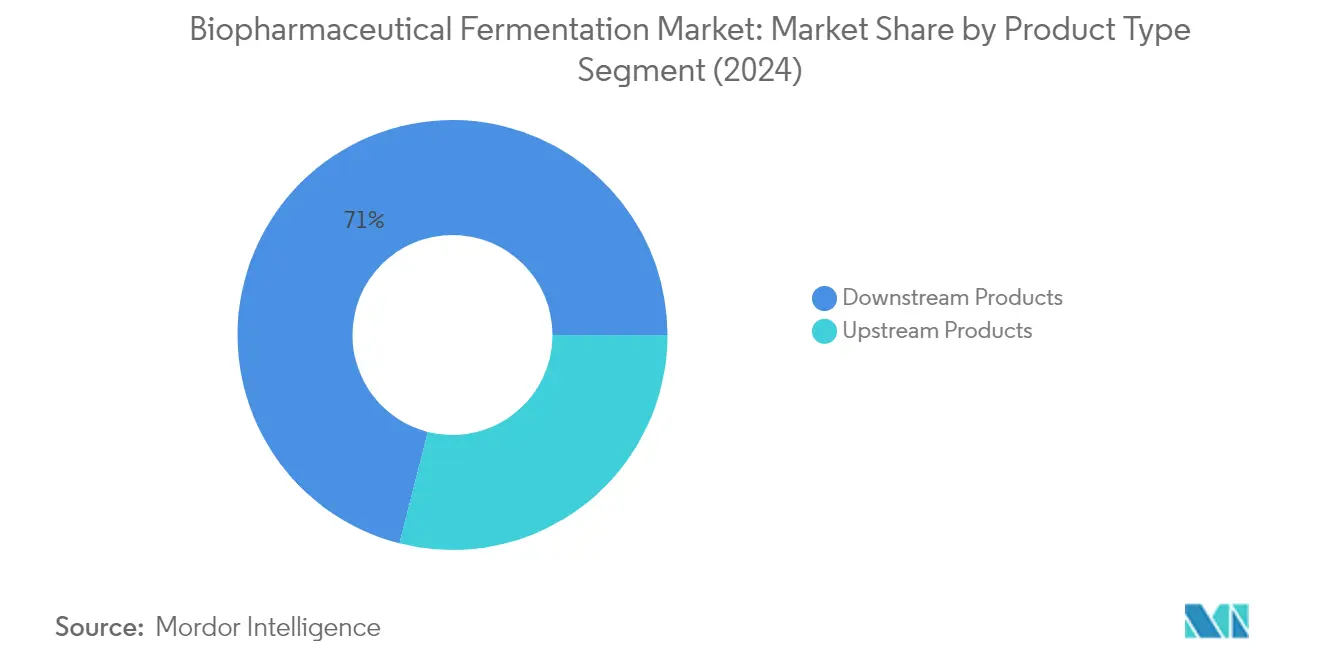
Upstream Products Segment in Biopharmaceutical Fermentation Market
The upstream products segment, while smaller in market share, plays a vital role in the biopharmaceutical fermentation process by providing essential equipment and materials for the initial stages of bioprocessing. This segment includes bioreactors/fermentors, bioprocess analyzers, process monitoring systems, and other upstream products necessary for cell cultivation and fermentation processes. The segment's growth is supported by increasing adoption of automated bioprocess systems, rising demand for single-use bioreactors, and continuous technological innovations in process monitoring and control systems. The expansion of biopharmaceutical manufacturing capacity globally, particularly in emerging markets, coupled with the growing trend towards process optimization and efficiency, continues to drive the demand for upstream products in the biopharmaceutical fermentation market. The integration of upstream bioprocessing and bioreactor industry advancements is crucial for enhancing the efficiency of cell culture fermentation processes.
Segment Analysis: By Application
Recombinant Proteins Segment in Biopharmaceutical Fermentation Market
The recombinant proteins segment dominates the biopharmaceutical fermentation market, holding approximately 44% market share in 2024. This segment's leadership position is driven by the increasing adoption of recombinant proteins in various therapeutic applications, particularly in cancer treatment and monoclonal antibody production. The segment's growth is further bolstered by significant investments in research and development activities, with major market players focusing on developing novel recombinant protein therapeutics. For instance, recent developments in 2023 include Repligen's partnership with Navigo Proteins to create innovative protein A ligands for antibody purification, demonstrating the continued innovation in this space. The segment is also experiencing rapid growth due to the expanding applications of recombinant proteins in treating complex diseases and the rising demand for personalized medicine approaches. The role of protein fermentation in enhancing the efficacy and production of these therapeutics is increasingly recognized.
Remaining Segments in Application Market Segmentation
The antibiotics segment represents a significant portion of the biopharmaceutical fermentation market, driven by the continuous need for new antibiotic development to combat evolving bacterial resistance. This segment's growth is supported by increasing investments in antibiotic research and development, particularly in developing economies. The other applications segment encompasses various applications including vaccines and gene therapy, demonstrating the versatility of fermentation technology in biopharmaceutical production. This segment is particularly dynamic due to the emerging applications in novel therapeutic areas and the growing focus on preventive healthcare solutions, especially in the context of global health challenges. The importance of vaccine fermentation in addressing these challenges is underscored by recent advancements.
Segment Analysis: By End User
Biopharmaceutical Industries Segment in Biopharmaceutical Fermentation Market
The biopharmaceutical industries segment continues to dominate the global biopharmaceutical fermentation market, holding approximately 67% of the market share in 2024. This significant market position is driven by the increasing demand for biopharmaceuticals across various therapeutic areas, including cancer, diabetes, and autoimmune diseases. The segment's growth is further supported by substantial investments in research and development activities, technological advancements in fermentation processes, and the expansion of manufacturing facilities worldwide. Major biopharmaceutical companies are increasingly focusing on developing novel biological drugs and expanding their production capabilities through state-of-the-art fermentation technologies. The rising adoption of single-use bioreactors, automated process control systems, and advanced monitoring tools has also contributed to the segment's dominance. Additionally, the growing trend towards personalized medicine and the increasing prevalence of chronic diseases have created a robust demand for biopharmaceutical products, further strengthening this segment's market position. The integration of bioprocess fermentation technologies is pivotal for maintaining a competitive advantage in the bioreactor industry.
CROs and CDMOs Segment in Biopharmaceutical Fermentation Market
The Contract Research Organizations (CROs) and Contract Development and Manufacturing Organizations (CDMOs) segment is experiencing the fastest growth in the biopharmaceutical fermentation market, with a projected growth rate of approximately 10% from 2024 to 2029. This remarkable growth is primarily attributed to the increasing trend of outsourcing biopharmaceutical research, development, and manufacturing activities by pharmaceutical companies. The segment is benefiting from the rising demand for cost-effective drug development and manufacturing solutions, coupled with the need for specialized expertise in bioprocessing. CROs and CDMOs are continuously expanding their capabilities through investments in advanced fermentation technologies and facilities across different regions. The segment's growth is further supported by the increasing complexity of biological drugs, which requires specialized manufacturing expertise and sophisticated fermentation processes. Additionally, these organizations are strengthening their market position by offering end-to-end services, from early-stage development to commercial manufacturing, making them attractive partners for both established pharmaceutical companies and emerging biotech firms.
Remaining Segments in End User Market
The academic research institutes segment plays a crucial role in advancing biopharmaceutical fermentation technology through fundamental research and innovation. These institutions contribute significantly to the development of novel fermentation techniques, process optimization strategies, and new applications in biopharmaceutical production. Academic research institutes are instrumental in conducting early-stage research that often leads to breakthrough discoveries in fermentation technology and bioprocessing methods. They also serve as important training grounds for future professionals in the biopharmaceutical industry, fostering expertise in fermentation technologies and bioprocess development. The collaboration between academic institutions and industry partners has become increasingly important, creating valuable synergies that drive innovation in biopharmaceutical fermentation processes and technologies. Furthermore, these institutions often serve as testing grounds for new fermentation technologies and methodologies before their commercial implementation.
Biopharmaceutical Fermentation Market Geography Segment Analysis
Biopharmaceutical Fermentation Market in North America
North America represents the dominant region in the global biopharmaceutical fermentation market, driven by advanced healthcare infrastructure, significant research and development activities, and the presence of major pharmaceutical companies. The region benefits from substantial investments in biotechnology research, a strong regulatory framework, and increasing demand for biotech-based drugs. The United States leads the regional market, followed by Canada and Mexico, with each country contributing uniquely to regional growth through their respective healthcare systems and pharmaceutical manufacturing capabilities.
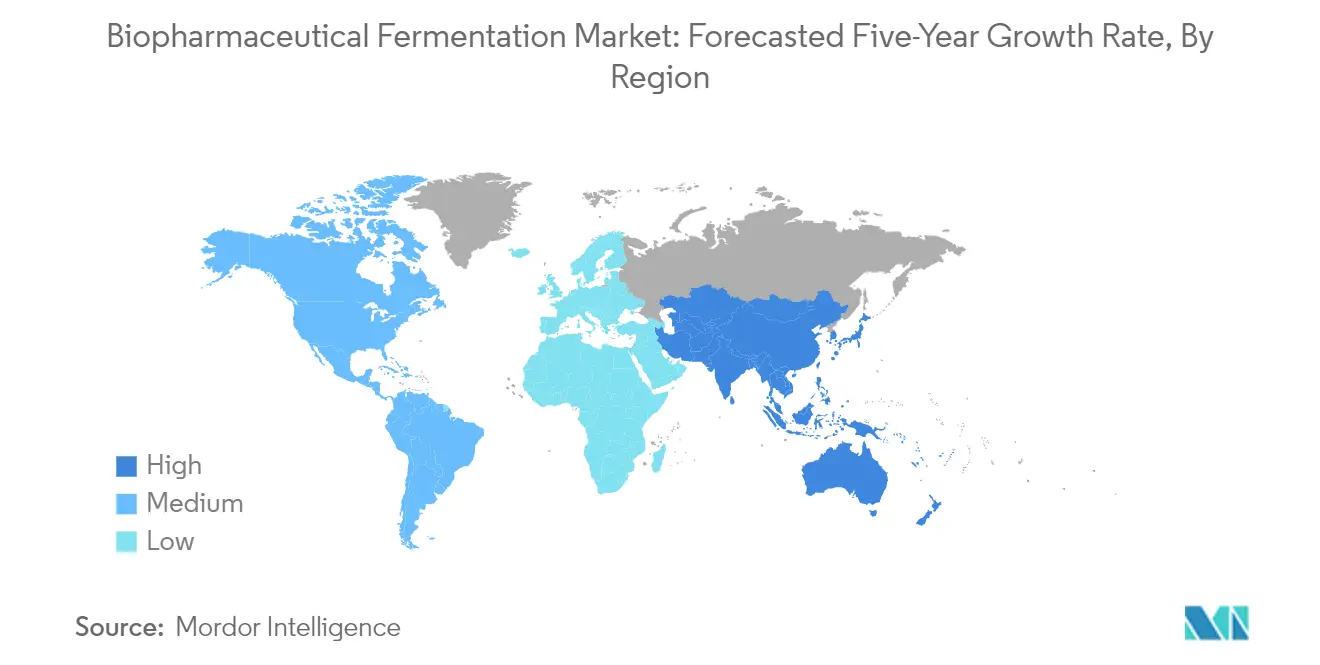
Biopharmaceutical Fermentation Market in the United States
The United States dominates the North American biopharmaceutical fermentation market, holding approximately 92% of the regional market share in 2024. The country's market leadership is attributed to its robust pharmaceutical industry, extensive research infrastructure, and significant investments in biotechnology. The presence of major market players, advanced manufacturing facilities, and supportive government policies has established the U.S. as a hub for biomanufacturing innovation. The country's market is characterized by increasing demand for biotech-based drugs, rising research and development activities, and growing expenditure for development and advancements in bioprocess technology.
Biopharmaceutical Fermentation Market in Canada
Canada emerges as the fastest-growing market in North America, with a projected growth rate of approximately 10% during 2024-2029. The country's market growth is driven by increasing research and development activities, rising prevalence of chronic diseases, and strategic initiatives by market players to expand biomanufacturing offerings. Canada's healthcare system and strong focus on biotechnology innovation create favorable conditions for market expansion. The country's commitment to advancing its biopharmaceutical fermentation capabilities, coupled with increasing investments in research infrastructure, positions it well for sustained growth in the coming years.
Biopharmaceutical Fermentation Market in Europe
Europe represents a significant market for biopharmaceutical fermentation, characterized by advanced healthcare systems, strong research capabilities, and the presence of established pharmaceutical companies. The region's market is driven by increasing investments in biotechnology, rising demand for biological drugs, and a growing focus on personalized medicine. Key countries including Germany, the United Kingdom, France, Italy, and Spain contribute significantly to the regional market, each with their unique strengths in research, development, and manufacturing capabilities.
Biopharmaceutical Fermentation Market in Germany
Germany maintains its position as the largest market in Europe, commanding approximately 28% of the regional market share in 2024. The country's dominance is supported by its robust pharmaceutical industry, advanced manufacturing capabilities, and strong focus on research and development. Germany's market is characterized by the presence of major biopharmaceutical fermentation companies, state-of-the-art research facilities, and significant investments in biotechnology innovation. The country's commitment to advancing biological drug development and manufacturing excellence continues to drive market growth.
Biopharmaceutical Fermentation Market in France
France emerges as the fastest-growing market in Europe, with a projected growth rate of approximately 12% during 2024-2029. The country's market growth is driven by increasing investments in biotechnology research, rising demand for biological drugs, and supportive government policies. France's strong focus on innovation in healthcare and biotechnology, coupled with the presence of leading research institutions and pharmaceutical companies, creates a favorable environment for market expansion. The country's commitment to advancing its biomanufacturing capabilities positions it well for continued growth.
Biopharmaceutical Fermentation Market in Asia-Pacific
The Asia-Pacific region represents a rapidly evolving market for biopharmaceutical fermentation, characterized by increasing investments in biotechnology, growing healthcare infrastructure, and rising demand for biological drugs. The region benefits from the presence of major pharmaceutical manufacturing hubs, particularly in China, Japan, and India. South Korea and Australia also contribute significantly to the regional market through their advanced research capabilities and growing biotechnology sectors. The region's market dynamics are shaped by increasing healthcare expenditure, growing prevalence of chronic diseases, and a rising focus on domestic production of biological drugs.
Biopharmaceutical Fermentation Market in China
China stands as the largest market in the Asia-Pacific region, driven by its extensive manufacturing capabilities, growing biotechnology sector, and significant investments in research and development. The country's market leadership is supported by government initiatives promoting domestic biomanufacturing production, the presence of major manufacturing facilities, and an increasing focus on innovation in biological drug development. China's commitment to advancing its biotechnology capabilities and expanding its pharmaceutical manufacturing base continues to strengthen its position in the regional market.
Biopharmaceutical Fermentation Market in India
India emerges as the fastest-growing market in the Asia-Pacific region, driven by its expanding biotechnology sector, increasing investments in research and development, and growing focus on biological drug manufacturing. The country's market growth is supported by its strong pharmaceutical manufacturing base, rising healthcare expenditure, and government initiatives promoting biotechnology innovation. India's developing healthcare infrastructure and increasing focus on domestic production of biological drugs position it well for sustained growth in the coming years.
Biopharmaceutical Fermentation Market in Middle East & Africa
The Middle East & Africa region demonstrates growing potential in the biopharmaceutical fermentation market, with increasing investments in healthcare infrastructure and a rising focus on biotechnology development. The region's market is primarily driven by the GCC countries and South Africa, with the GCC emerging as the largest market and South Africa showing the fastest growth. The region's market development is supported by increasing healthcare expenditure, growing awareness about biological drugs, and rising investments in pharmaceutical manufacturing capabilities.
Biopharmaceutical Fermentation Market in South America
South America represents an emerging market for biopharmaceutical fermentation, characterized by growing healthcare infrastructure and increasing investments in biotechnology. The region's market is primarily driven by Brazil and Argentina, with Brazil emerging as both the largest and fastest-growing market. The region's market development is supported by increasing healthcare expenditure, rising prevalence of chronic diseases, and a growing focus on the domestic production of biological drugs.
Biopharmaceutical Fermentation Industry Overview
Top Companies in Biopharmaceutical Fermentation Market
The biopharmaceutical fermentation market features prominent players like Thermo Fisher Scientific, Danaher Corporation, Sartorius Stedim Biotech, Merck KGaA, and Eppendorf AG leading the innovation landscape. These companies are actively pursuing product development through significant R&D investments, particularly in single-use technologies and advanced bioreactor systems. Strategic collaborations and partnerships with biotechnology firms and research institutions have become increasingly common to enhance technological capabilities and expand market reach. Companies are focusing on expanding their manufacturing facilities globally, with particular emphasis on high-growth markets in Asia-Pacific. The industry has seen a strong trend toward developing integrated solutions that combine fermentation technology with analytical tools and software platforms. Market leaders are also prioritizing the development of scalable solutions that can support both research-scale and commercial-scale biomanufacturing production.
Dynamic Market Structure Drives Industry Evolution
The biopharmaceutical fermentation market exhibits a relatively consolidated structure, dominated by large multinational corporations with diverse product portfolios spanning multiple segments of the bioprocess technology market. These established players leverage their extensive R&D capabilities, global distribution networks, and strong financial positions to maintain market leadership. The market has witnessed significant merger and acquisition activity, with larger companies acquiring specialized technology providers to enhance their product offerings and gain access to innovative biofermentation technologies. Regional players, particularly in emerging markets, are increasingly forming strategic partnerships with global leaders to strengthen their market presence and technical capabilities.
The competitive dynamics are characterized by a mix of integrated solution providers and specialized equipment manufacturers, each serving distinct market segments. Major pharmaceutical and biotechnology companies often maintain long-term relationships with key equipment and consumable suppliers, creating high barriers to entry for new market participants. The industry has seen increased investment in contract development and manufacturing organizations (CDMOs), which has created new opportunities for equipment suppliers while also driving consolidation in the market.
Innovation and Adaptability Drive Future Success
Success in the biopharmaceutical fermentation market increasingly depends on companies' ability to provide comprehensive solutions that address the evolving needs of both established pharmaceutical companies and emerging biotech firms. Market players must focus on developing flexible and scalable technologies that can accommodate various biological products while maintaining cost-effectiveness and regulatory compliance. The ability to offer integrated solutions that combine hardware, software, and services has become crucial for maintaining competitive advantage. Companies must also invest in building strong technical support networks and application expertise to help customers optimize their bioprocessing operations.
Future market leadership will require companies to balance innovation with operational efficiency while maintaining strong relationships with end-users. Successful players will need to demonstrate expertise in emerging therapeutic areas and new modalities while ensuring their solutions meet increasingly stringent regulatory requirements. The market shows relatively low substitution risk due to the specialized nature of bioreactor equipment and high regulatory barriers, but companies must continue to innovate to maintain their competitive positions. Regional expansion strategies, particularly in emerging markets, will become increasingly important as companies seek to capture growth opportunities while managing supply chain complexities and regulatory requirements across different regions.
Biopharmaceutical Fermentation Market Leaders
-
Eppendorf AG
-
Lonza Group AG
-
Thermo Fisher Scientific Inc.
-
Sartorius Stedim Biotech
-
Agilent Technologies
- *Disclaimer: Major Players sorted in no particular order
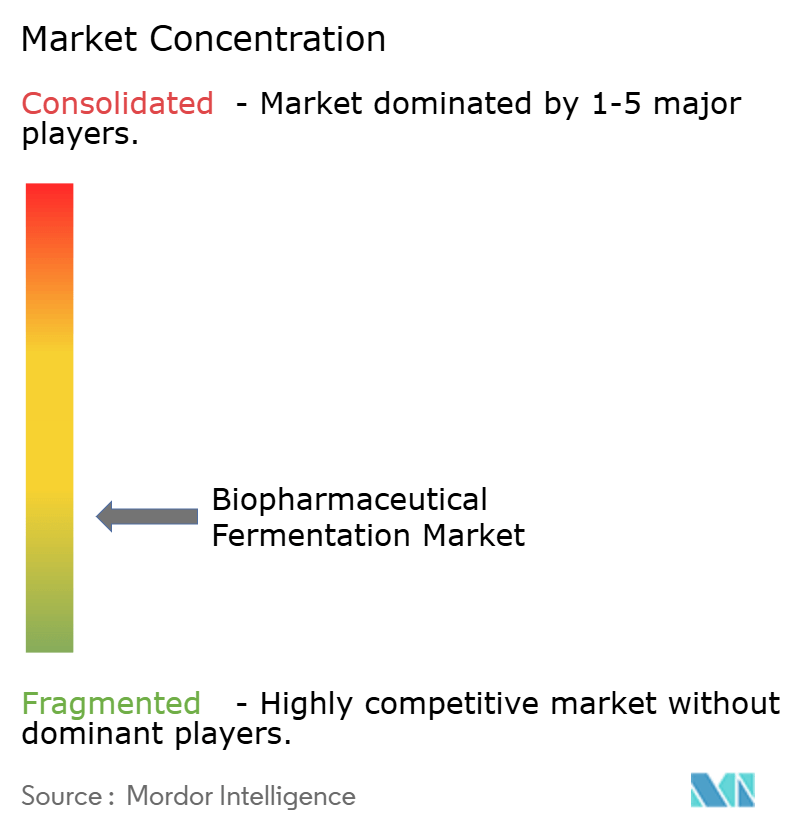
Biopharmaceutical Fermentation Market News
- January 2024: Agilent Technologies launched the Agilent ProtegAnalyzer system, an automated parallel capillary electrophoresis platform designed for protein analysis. This cutting-edge system not only streamlines but also boosts the efficiency of analyzing complex protein mixtures. Such analysis is crucial in diverse sectors, spanning pharmaceuticals, biotechnology, food analysis, and academia.
- April 2023: 3M reported a USD 146 million investment to enhance its support for biotech manufacturing, a swiftly evolving sector in healthcare known for developing groundbreaking therapies. This funding will accelerate 3M's creation and supply of crucial filtration equipment designed for bioprocessing and pharmaceutical manufacturing. These advancements will enable biotech clients to continue their innovation in therapies for ailments like rheumatoid arthritis, multiple sclerosis, and certain cancers.
Biopharmaceutical Fermentation Market Report - Table of Contents
1. INTRODUCTION
- 1.1 Study Assumptions and Market Definition
- 1.2 Scope of the Study
2. RESEARCH METHODOLOGY
3. EXECUTIVE SUMMARY
4. MARKET DYNAMICS
- 4.1 Market Overview
-
4.2 Market Drivers
- 4.2.1 Increasing Demand for Biotech based Drugs
- 4.2.2 Rising Research and Development Activities to Produce Novel Biological Drugs
-
4.3 Market Restraints
- 4.3.1 High Cost of Biopharmaceutical Fermentation and its Installation
-
4.4 Porter's Five Force Analysis
- 4.4.1 Threat of New Entrants
- 4.4.2 Bargaining Power of Buyers/Consumers
- 4.4.3 Bargaining Power of Suppliers
- 4.4.4 Threat of Substitute Products
- 4.4.5 Intensity of Competitive Rivalry
5. MARKET SEGMENTATION (Market Size by Value - USD million)
-
5.1 By Product Type
- 5.1.1 Upstreams Products
- 5.1.1.1 Bioreactors/Fermentors
- 5.1.1.2 Bioprocess Analyzers
- 5.1.1.3 Process Monitoring System
- 5.1.1.4 Other Upstream Products
- 5.1.2 Downstream Products
- 5.1.2.1 Filtration and Seperation
- 5.1.2.2 Chromatography
- 5.1.2.3 Consumables and Acessories
- 5.1.2.4 Other Downstream Products
-
5.2 By Application
- 5.2.1 Antibiotics
- 5.2.2 Recombinant Proteins
- 5.2.3 Other Applications
-
5.3 By End User
- 5.3.1 Biopharmaceutical Industries
- 5.3.2 Contract Research Organization
- 5.3.3 Acedemic Research Institutes
- 5.3.4 Other End users
-
5.4 Geography
- 5.4.1 North America
- 5.4.1.1 United States
- 5.4.1.2 Canada
- 5.4.1.3 Mexico
- 5.4.2 Europe
- 5.4.2.1 Germany
- 5.4.2.2 United Kingdom
- 5.4.2.3 France
- 5.4.2.4 Italy
- 5.4.2.5 Spain
- 5.4.2.6 Rest of Europe
- 5.4.3 Asia-Pacific
- 5.4.3.1 China
- 5.4.3.2 Japan
- 5.4.3.3 India
- 5.4.3.4 Australia
- 5.4.3.5 South Korea
- 5.4.3.6 Rest of Asia-Pacific
- 5.4.4 Middle East and Africa
- 5.4.4.1 GCC
- 5.4.4.2 South Africa
- 5.4.4.3 Rest of Middle East and Africa
- 5.4.5 South America
- 5.4.5.1 Brazil
- 5.4.5.2 Argentina
- 5.4.5.3 Rest of South America
6. COMPETITIVE LANDSCAPE
-
6.1 Company Profiles
- 6.1.1 Agilent Technologies
- 6.1.2 Thermo Fisher Scientific Inc.
- 6.1.3 Lonza Group AG
- 6.1.4 Sartorius Stedim Biotech
- 6.1.5 Eppendorf AG
- 6.1.6 Danaher Corporation
- 6.1.7 F. Hoffmann-La Roche Ltd.
- 6.1.8 Nova Biomedical Corporation
- 6.1.9 Merck KGaA
- 6.1.10 Becton, Dickinson and Company
- *List Not Exhaustive
7. MARKET OPPORTUNITIES AND FUTURE TRENDS
Biopharmaceutical Fermentation Industry Segmentation
As per the scope of the report, biopharmaceutical fermentation systems, or bioprocessing, as the controlled incubation of microorganisms in enclosed tanks, managing aeration, agitation, temperature, and pH. The biopharmaceutical fermentation market is categorized by product type, applications, end users, and geography. Product types are divided into upstream and downstream categories. Upstream products encompass bioreactors/fermenters, bioprocess analyzers, and process monitoring systems. Downstream offerings include filtration and separation, chromatography, consumables and accessories, among others. Applications range from antibiotics and recombinant proteins to probiotics and more. End users consist of biopharmaceutical industries, contract research organizations (CROs), CDMOs, and academic research institutes. Geographically, the market spans North America, Europe, Asia-Pacific, the Middle East, Africa, and South America. The report also estimates market sizes and trends for 17 countries across these major regions, with sizing and forecasts based on revenue (USD) for each segment.
| By Product Type | Upstreams Products | Bioreactors/Fermentors | |
| Bioprocess Analyzers | |||
| Process Monitoring System | |||
| Other Upstream Products | |||
| Downstream Products | Filtration and Seperation | ||
| Chromatography | |||
| Consumables and Acessories | |||
| Other Downstream Products | |||
| By Application | Antibiotics | ||
| Recombinant Proteins | |||
| Other Applications | |||
| By End User | Biopharmaceutical Industries | ||
| Contract Research Organization | |||
| Acedemic Research Institutes | |||
| Other End users | |||
| Geography | North America | United States | |
| Canada | |||
| Mexico | |||
| Europe | Germany | ||
| United Kingdom | |||
| France | |||
| Italy | |||
| Spain | |||
| Rest of Europe | |||
| Asia-Pacific | China | ||
| Japan | |||
| India | |||
| Australia | |||
| South Korea | |||
| Rest of Asia-Pacific | |||
| Middle East and Africa | GCC | ||
| South Africa | |||
| Rest of Middle East and Africa | |||
| South America | Brazil | ||
| Argentina | |||
| Rest of South America | |||
Biopharmaceutical Fermentation Market Research Faqs
How big is the Biopharmaceutical Fermentation Market?
The Biopharmaceutical Fermentation Market size is expected to reach USD 25.02 billion in 2025 and grow at a CAGR of 7.93% to reach USD 36.64 billion by 2030.
What is the current Biopharmaceutical Fermentation Market size?
In 2025, the Biopharmaceutical Fermentation Market size is expected to reach USD 25.02 billion.
Who are the key players in Biopharmaceutical Fermentation Market?
Eppendorf AG, Lonza Group AG, Thermo Fisher Scientific Inc., Sartorius Stedim Biotech and Agilent Technologies are the major companies operating in the Biopharmaceutical Fermentation Market.
Which is the fastest growing region in Biopharmaceutical Fermentation Market?
Asia-Pacific is estimated to grow at the highest CAGR over the forecast period (2025-2030).
Which region has the biggest share in Biopharmaceutical Fermentation Market?
In 2025, the North America accounts for the largest market share in Biopharmaceutical Fermentation Market.
What years does this Biopharmaceutical Fermentation Market cover, and what was the market size in 2024?
In 2024, the Biopharmaceutical Fermentation Market size was estimated at USD 23.04 billion. The report covers the Biopharmaceutical Fermentation Market historical market size for years: 2021, 2022, 2023 and 2024. The report also forecasts the Biopharmaceutical Fermentation Market size for years: 2025, 2026, 2027, 2028, 2029 and 2030.
Our Best Selling Reports
Biopharmaceutical Fermentation Market Research
Mordor Intelligence provides comprehensive insights into the biopharmaceutical fermentation industry. We leverage extensive expertise in bioprocess technology and biomanufacturing analysis. Our research thoroughly examines the evolving landscape of industrial fermentation and bioreactor technologies. It covers crucial developments in microbial fermentation and bacterial fermentation processes. The detailed report, available for easy download as a PDF, offers an in-depth analysis of biofermentation methods and upstream bioprocessing technologies that are transforming the industry.
Our extensive coverage includes vital aspects of therapeutic protein production, recombinant protein production, and vaccine fermentation processes. The report analyzes the growing bioreactor market size and emerging trends in cell culture fermentation. It provides detailed insights into pharmaceutical fermentation developments. Stakeholders benefit from our thorough examination of protein fermentation techniques and bioprocess fermentation advancements. The expanding biomanufacturing industry is also addressed. The analysis includes precise biomanufacturing market size projections and a detailed evaluation of fermentation technology applications. This offers valuable insights for industry participants navigating the complex bioreactor industry landscape.




